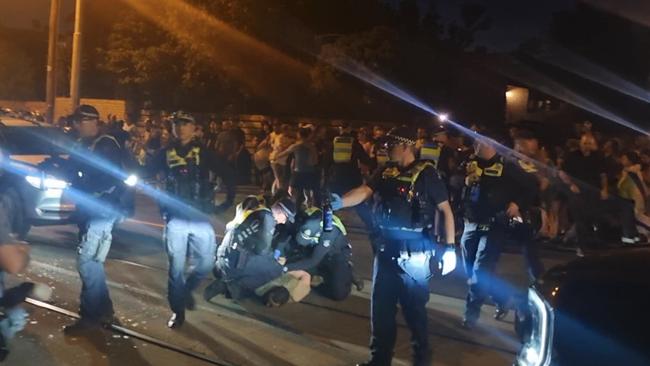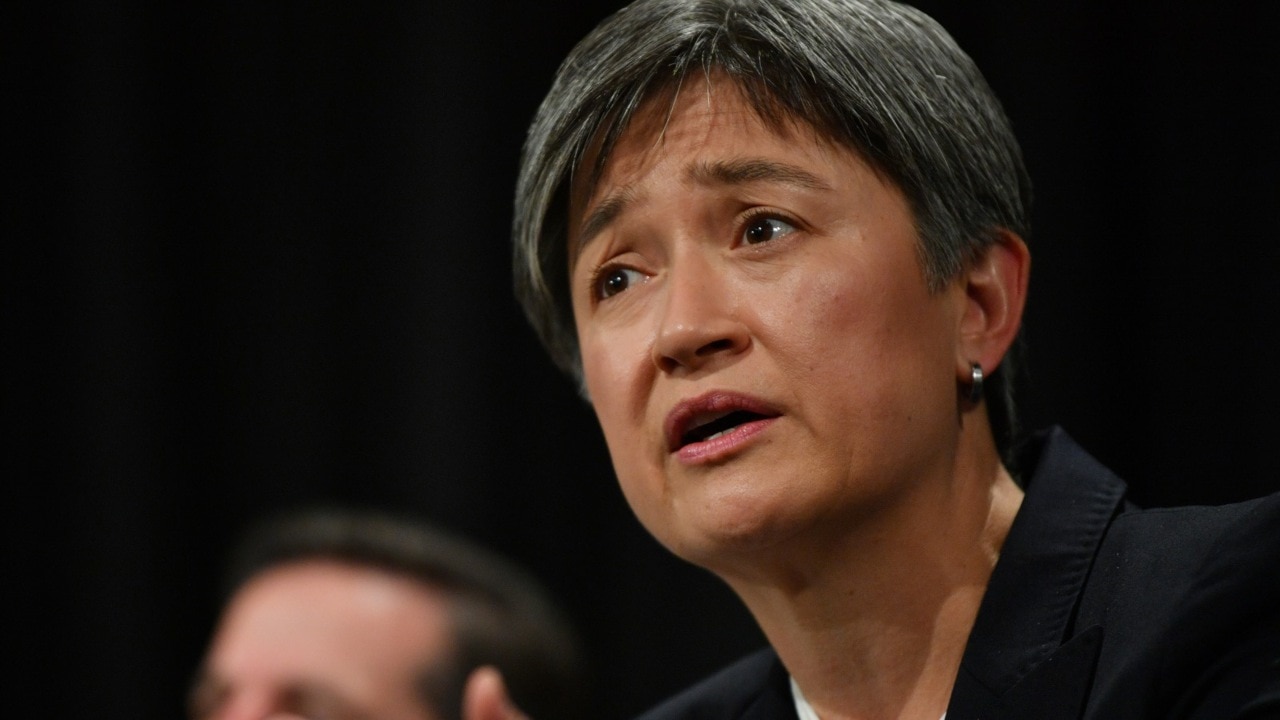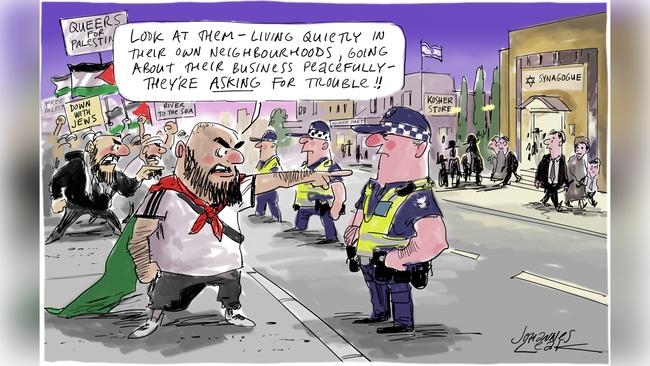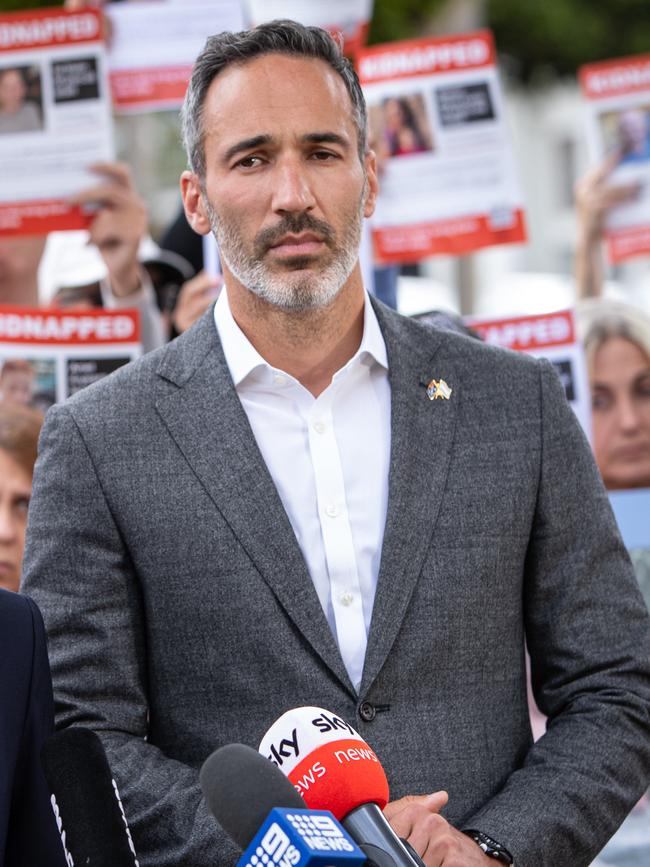
In response to this grotesquerie, Foreign Minister Penny Wong released a social media post condemning “anti-Semitism and Islamophobia” in reference to the “violence in Caulfield”.
While it is reasonable to warn against both forms of prejudice in the context of community tensions, only one of them was on display in Caulfield on Friday night.
Wong’s tendency to draw moral equivalences seems to be increasingly habitual. This was again evident on Sunday morning when she revealed the government is pushing for a ceasefire in the Hamas-Israel war, noting Israel needed to be held to higher standards.
In a recent photo posted to her official social media account, Wong stands next to Nasser Mashni, the president of the Australian Palestinian Advocacy Network. Last week it was revealed Mashni has a history of demonising Jewish people and as recently as last year he called for the destruction of Israel.
I shared my deepest condolences with @iamthenas from the Australian Palestinian Advocacy Network, following the devastating explosion at the Gaza City Hospital.
— Senator Penny Wong (@SenatorWong) October 18, 2023
We mourn the loss of every civilian life. pic.twitter.com/B1iCvrTGzp
“The power structures that exist in the world all focus upon Zionism,” Mashni said on his radio show. “Israel is the domino. Israel falls over, not just the Middle East – South America, the Africans, the world is a far better place once we destroy Western imperialist control of the world.”

While there is no suggestion Wong knew of such rhetoric when she posed for a photograph with Mashni, the incident highlights a major blind spot when it comes to anti-Semitism on the left.
Of course, the roots of anti-Semitism stretch deep into history, and Jew hatred has attached itself to many different ideologies. Early leaders of Christianity wrote polemics against the Jews, and derogatory references can be found within Islamic texts. But, while it’s important to acknowledge these historical forms of prejudice, contemporary variants have also become relevant today.

One of the most influential pieces of modern anti-Semitism is the Protocols of the Elders of Zion, a forged document that emerged from Imperial Russia in 1903. This document popularised the conspiracy theory that Jews were engaged in worldwide control. Hitler referred to the Protocols in Mein Kampf and this conspiracy theory became part of the broader Nazi propaganda campaign.
Yet while the Nazis were defeated in 1945, the Protocols did not die with them. The Soviets repurposed the Protocol’s conspiracy theories in their own propaganda during the Cold War, which ramped up after Israel’s victory in the Six-Day War. In order to signal support to Egypt and Syria (who had lost the war) anti-Zionist propaganda became part of the Soviet’s broader Cold War strategy. This strategy aimed to push back against the US and strengthen Soviet influence in the Middle East.

Izabella Tabarovsky, a scholar of Soviet Jewry, writes that the Soviets took Nazi propaganda and simply substituted the word “Zionist” in place of “Jew”. She explains: “Soviet ideologues relied for inspiration on the Protocols of the Elders of Zion, on the ideas of classic religious anti-Semitism, and even Mein Kampf, but adapted them to the Marxist framework by substituting the idea of a global anti-Soviet Zionist conspiracy for a specifically Jewish one.”

Such propaganda spread through multiple channels. In the ’60s and ’70s, newspapers such as Pravda published cartoons that were then reprinted by communist-aligned media in the West.
Tabarovsky points out that the Soviets were well aware Europeans were particularly sensitive to accusations of racism, and of anything associated with Nazi Germany – so they cynically used this against Israel by equating Zionism with Nazism. Soviet cartoons of the ’70s depict Jews looking into mirrors only to be greeted with reflections of Hitler, and Stars of David superimposed over swastikas.
In 1975, a UN General Assembly resolution was passed that declared “Zionism is Racism”. The controversial resolution was passed only with support of the Soviet bloc, Arab states and various African nations (it was overturned in 1991). Michael Heller and Aleksandr M. Nekrich, historians of the Soviet Union, argue this resolution was one of the Soviets’ “greatest victories”.
It was a victory because it successfully decoupled the demonisation of the Jewish people from associations with the far right. As Quillette editor Jamie Palmer wrote in 2016: “The claims that Zionism is racism, the instrument or puppeteer of Jewish and American imperialists, a project of Western colonialism, or a template for Jewish world domination; that Zionists were co-conspirators and ideological ancestors of Nazi Germany who control markets, industry, and media, and; that Israel is a ‘terrorist regime’ – all such claims originated in Soviet propaganda and are widespread on today’s activist left.”

The Soviets targeted Israel with their propaganda because they saw the only parliamentary democracy in the Middle East as a proxy for the West. In a recent address, Russian President Vladimir Putin said his “fists clench and eyes tear up” over Israeli military actions in Gaza drawing parallels between the Russian military and Hamas.
The scenes in Caulfield, where pro-Palestinian groups tried to intimidate local Jews, are echoed worldwide, from Ivy League campuses in the US to the streets of London during Remembrance Day.
I asked Alex Ryvchin, co-chief executive of the Executive Council of Australian Jewry, about rising anti-Semitism in Australia. He told me by email: “There is a lag in reporting and chronic underreporting due to shame and embarrassment, but the incidents we have received show an increase of at least 600 per cent from the previous month.”

But aside from the explosion in incidents, what alarms Ryvchin the most is the “mindset of the contemporary anti-Semite”. Explaining that “the expulsion or destruction of Jews was always framed as a necessary, righteous act”, he sees the attitude appearing on Australian streets today. The mindset of today’s anti-Semites, according to Ryvchin, “is what is most concerning because it means there is no shame in their deeds and instead a sense of mission and purpose that can turn an aggressive fringe movement into something truly terrifying”.
Ryvchin’s observations reveal a disturbing normalisation of anti-Semitism. And at least some of it stems from the fact that the left has never grappled with its own history of anti-Semitism. And is ill-equipped to deal with it when it arises.
If a Coalition minister posed in a photograph with a neo-Nazi who had called for Jews to be murdered on a radio show, the Australian media and public would rightly be apoplectic. But Australia’s Foreign Minister can pose with the left-wing equivalent, and it barely raises a yawn.
Claire Lehmann is founding editor of online magazine Quillette.








On Friday night a pro-Palestinian mob descended on Caulfield, in the heart of Melbourne’s Jewish community, and incited anti-Semitic violence on the 85th anniversary of Kristallnacht.